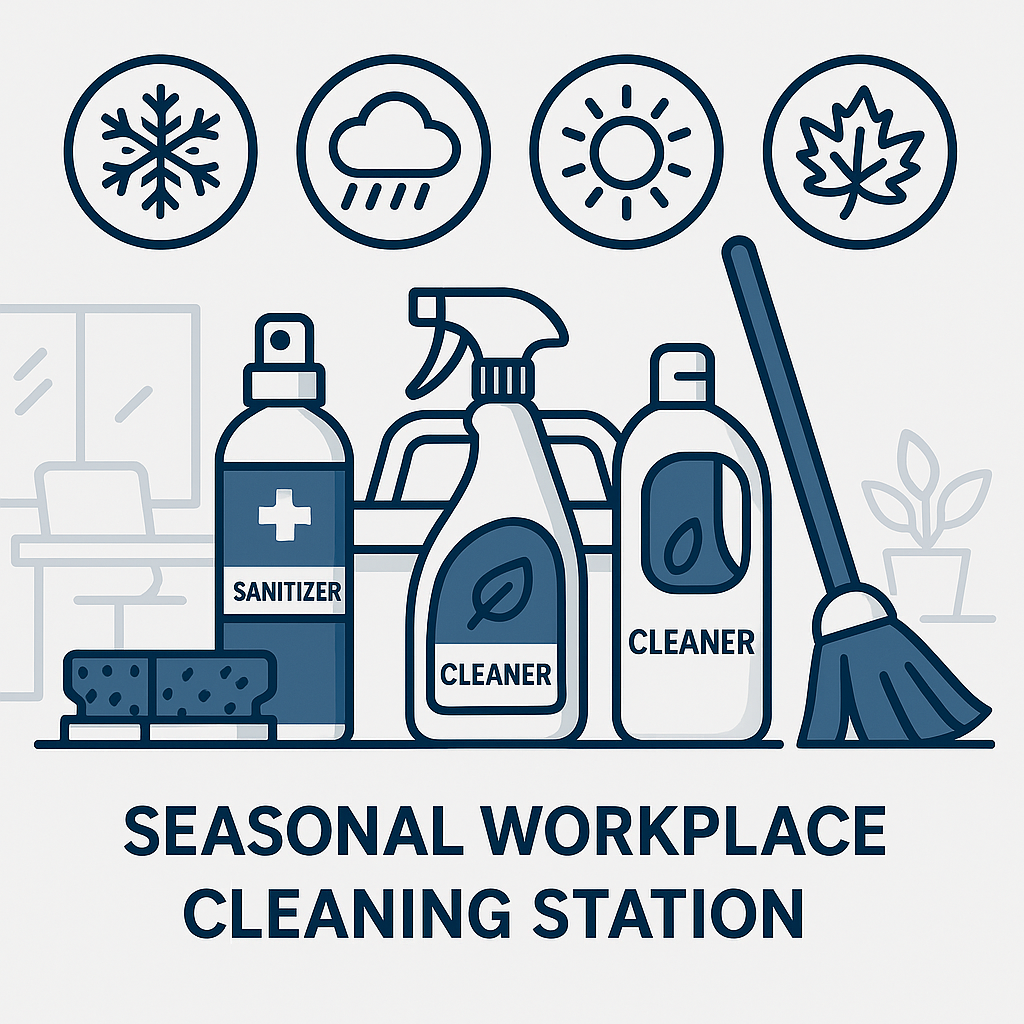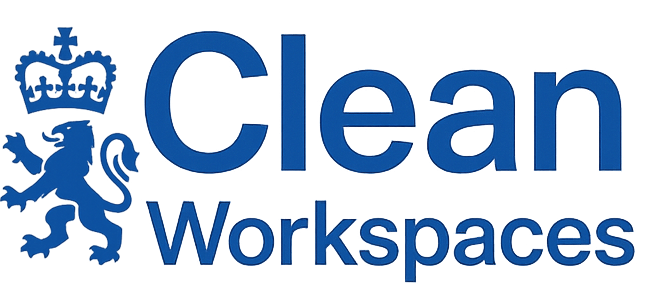Seasonal Cleaning Considerations for UK Businesses
Adapting your workplace hygiene protocols to address changing seasonal challenges

The United Kingdom's distinct seasons present unique challenges for workplace cleanliness and hygiene. From winter's cold and flu concerns to summer's pollen and humidity issues, adapting your cleaning protocols seasonally helps maintain optimal workplace health year-round.
The Impact of Seasonal Changes on Workplace Hygiene
British weather patterns significantly influence workplace cleanliness in ways that aren't always obvious. Each season introduces specific challenges:
- Seasonal illness patterns: Different types of viral and bacterial illnesses prevail in different seasons, affecting transmission risks
- Weather-related contaminants: Rain, snow, pollen, and other outdoor elements are tracked into buildings in varying amounts throughout the year
- Humidity and temperature fluctuations: These affect microbial growth patterns and cleaning product effectiveness
- Occupancy pattern changes: Many workplaces experience seasonal variations in staffing levels, visitor numbers, and usage patterns
- HVAC system adjustments: Seasonal transitions between heating and cooling affect indoor air quality and circulation patterns
According to our economic impact research, organizations that adjust their cleaning protocols seasonally report 22% fewer illness-related absences compared to those that maintain static year-round approaches.
Winter (December-February): Cold and Flu Season Intensity
Winter presents perhaps the most significant hygiene challenges for UK workplaces, with increased viral transmission, extended pathogen survival on surfaces, and employees spending more time indoors in close proximity.
Winter Hygiene Challenges
- • Peak cold and flu transmission periods
- • Increased wet weather tracking (mud, slush)
- • Extended pathogen viability on surfaces due to indoor heating creating dry air
- • Winter clothing acting as fomites (virus carriers)
- • Reduced natural ventilation due to closed windows
Winter Protocol Adjustments
- • Increase high-touch surface disinfection frequency
- • Deploy additional entrance matting systems
- • Implement humidification solutions (40-60% ideal)
- • Add hand sanitizing stations near entrances
- • Enhance air filtration with HEPA systems
Winter cleaning strategies should prioritize infection control, with particular attention to high-touch surfaces detailed in our infection control best practices guide. Consider adding antiviral disinfectants to your cleaning protocols during peak flu season, especially for shared workstations, meeting rooms, and communal areas.
Winter Pro Tip
Consider adding UV-C air purification systems during winter months when natural ventilation is reduced. These systems can deactivate airborne pathogens as they're recirculated through heating systems.
Spring (March-May): Controlling Allergens and Dampness
Spring brings changing weather patterns, increased pollen counts, and often unpredictable precipitation that creates unique cleaning challenges for UK facilities.
Spring Hygiene Challenges
- • Rising pollen levels affecting indoor air quality
- • Increased rainfall creating dampness issues
- • Mud and soil tracking from outdoor activities
- • Potential mould growth from fluctuating humidity
- • Seasonal staff allergies affecting productivity
Spring Protocol Adjustments
- • Implement enhanced HVAC filter changes
- • Increase carpet cleaning frequency
- • Clean window frames and sills more regularly
- • Deploy dehumidification in problem areas
- • Schedule deep cleaning of fabric surfaces
Spring cleaning should emphasize allergen control and moisture management. Pay particular attention to ventilation systems, which may need more frequent filter changes as they bring in pollen-laden outside air. Consider implementing a regular desk cleaning protocol that includes wiping horizontal surfaces where allergens settle.
Special attention should be paid to entry areas during wet spring weather. Enhanced matting systems at entrances help reduce water and mud tracking. In particularly damp periods, consider deploying commercial dehumidifiers in problem areas, as excess moisture can quickly lead to mould growth in carpets and fabric surfaces.
Summer (June-August): Heat, Humidity and Air Quality
Summer brings warmer temperatures, higher humidity levels, and unique cleaning challenges related to air conditioning systems and increased bacterial growth rates.
Summer Hygiene Challenges
- • Accelerated bacterial growth in warm conditions
- • Air conditioning systems recirculating microorganisms
- • Increased insects and pest presence
- • Potential odour issues from humidity
- • Food spoilage risks in break areas
Summer Protocol Adjustments
- • More frequent cleaning of refrigerators/food areas
- • Air conditioning maintenance and cleaning
- • Implement targeted pest control measures
- • Increase bin emptying frequency
- • Implement additional odour control systems
Summer cleaning protocols should address the faster bacterial growth rates that occur in warmer conditions. Our surface disinfection guidelines include specific recommendations for summer months, when disinfectants may evaporate more quickly and require adjusted contact times.
Air conditioning systems require particular attention during summer. Cooling coils and condensate pans can become breeding grounds for bacteria and mould when continuously operating. Schedule professional HVAC system cleaning, with special attention to cooling components and filters. These systems can spread microorganisms throughout your facility if not properly maintained.
Summer Pro Tip
Consider implementing a more stringent food storage policy during summer months. Food left in desk areas can attract insects and create odour issues much more quickly than in cooler months. Designate specific food consumption areas with enhanced cleaning schedules.
Autumn (September-November): Falling Leaves and Returning Illnesses
Autumn represents a transition period with unique challenges as weather cools, illness rates begin to rise, and external debris increases. This season often combines elements of both summer and winter challenges.
Autumn Hygiene Challenges
- • Increased external debris (leaves, etc.)
- • Rising illness rates as temperatures drop
- • Transition from cooling to heating systems
- • Variable humidity creating condensation issues
- • Wet weather increasing slip hazards
Autumn Protocol Adjustments
- • Enhanced entrance cleaning procedures
- • Beginning transition to winter disinfection protocols
- • HVAC system transition cleaning
- • Increase floor cleaning/maintenance
- • Implement slip prevention measures
Autumn cleaning protocols should focus on managing the transition period. As heating systems are reactivated, schedule a comprehensive HVAC cleaning to remove dust and debris that may have accumulated during dormancy. This helps prevent the circulation of irritants and the "burning dust" smell often associated with heating system reactivation.
Entrance areas require particular attention during autumn, as falling leaves and increasing rainfall create significant debris tracking issues. Consider increasing the frequency of entrance matting cleaning and extending matting coverage during this period. This approach, detailed in our workplace hygiene policy guide, helps prevent slip hazards while reducing cleaning requirements throughout the facility.
Implementing a Seasonal Cleaning Calendar
Creating a formal seasonal cleaning calendar helps ensure appropriate adjustments are made proactively rather than reactively. A comprehensive seasonal approach includes:
- Core year-round protocols: Fundamental cleaning practices that remain consistent regardless of season
- Seasonal protocol adjustments: Specific modifications implemented during different seasons
- Transitional period procedures: Special attention to system changes and cleaning needs during seasonal transitions
- Supply management strategies: Ensuring appropriate cleaning chemicals and equipment are available for seasonal needs
- Staff training updates: Brief refreshers for cleaning staff about seasonal priority changes
This formal approach ensures that seasonal adjustments aren't overlooked and that appropriate resources are allocated to address changing cleaning needs throughout the year.
Sample Seasonal Cleaning Schedule Components
| Cleaning Element | Winter | Spring | Summer | Autumn |
|---|---|---|---|---|
| High-touch disinfection | 3-4x daily | 2-3x daily | 1-2x daily | 2-3x daily |
| HVAC attention | Heating system | Filter changes | Cooling system | System transition |
| Floor care focus | Salt/moisture | Mud/rain | Standard | Leaves/debris |
| Window cleaning | Monthly | Bi-weekly | Monthly | Bi-weekly |
Conclusion: Proactive Seasonal Adaptations
Effective workplace cleaning isn't static—it requires thoughtful adjustments to address the unique challenges presented by each season in the United Kingdom. By adopting a seasonal approach, businesses can maintain consistently high hygiene standards year-round while optimizing resource allocation.
The changing seasons affect not only cleaning requirements but also occupant expectations and perceptions. Visible adaptations to seasonal challenges, such as additional entrance matting during wet weather or enhanced hand hygiene stations during winter, demonstrate organizational attentiveness to occupant needs. This attention to detail contributes to overall workplace satisfaction and wellbeing.
For more detailed guidance on season-specific cleaning protocols for your industry, contact our consulting team for a customized assessment. You may also want to explore our infection control best practices and surface testing methods for complementary approaches to maintaining high hygiene standards throughout the year.
Related Articles
Infection Control Best Practices for High-Traffic Facilities
Specialized hygiene protocols for managing transmission risks in busy environments.
Surface Testing Methods: Ensuring Cleaning Efficacy
Verification techniques for confirming your protocols are working.
Creating an Effective Workplace Hygiene Policy
Step-by-step guidance for developing comprehensive standards.
Seasonal Assessment
Need help adapting your cleaning protocols for seasonal changes? Our consulting team can conduct a site-specific assessment and provide customized recommendations.
Request Consultation